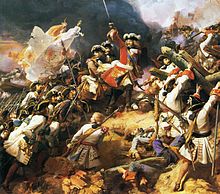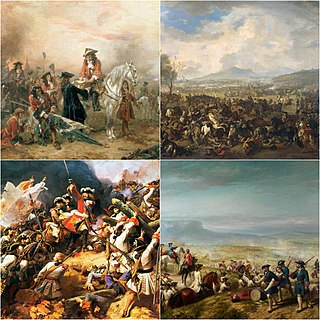
The War of the Spanish Succession was a European great power conflict fought between 1701 and 1714. The immediate cause was the death of the childless Charles II of Spain in November 1700, which led to a struggle for control of the Spanish Empire. His nominated heir was Philip of Anjou, a grandson of Louis XIV of France, whose main backers were France and most of Spain. His rival, Archduke Charles of Austria, was supported by the Grand Alliance, whose primary members included the Holy Roman Empire, the Dutch Republic, and Great Britain. Significant related conflicts include the 1700 to 1721 Great Northern War, and Queen Anne's War in North America.

General John Churchill, 1st Duke of Marlborough, 1st Prince of Mindelheim, 1st Count of Nellenburg, Prince of the Holy Roman Empire, was an English soldier and statesman. From a gentry family, he served as a page at the court of the House of Stuart under James, Duke of York, through the 1670s and early 1680s, earning military and political advancement through his courage and diplomatic skill. He is known for never having lost a battle.

The Battle of Denain was fought on 24 July 1712 as part of the War of the Spanish Succession. It resulted in a French victory, under Marshal Villars, against Dutch and Austrian forces, under Prince Eugene of Savoy.
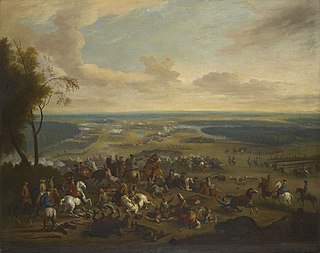
The Battle of Malplaquet took place on 11 September 1709 during the War of the Spanish Succession, near Taisnières-sur-Hon in modern France, then part of the Spanish Netherlands. A French army of around 75,000 men, commanded by the Duke of Villars, engaged a Grand Alliance force of 86,000 under the Duke of Marlborough. In one of the bloodiest battles of the 18th century, the Allies won a narrow victory, but suffered heavy casualties.
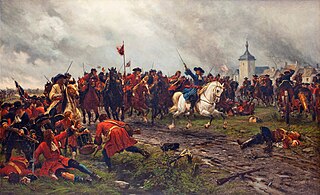
The Battle of Landen, took place on 29 July 1693, during the Nine Years' War near Landen, then in the Spanish Netherlands, now part of Belgium. A French army under Marshal Luxembourg defeated an Allied force led by William III.

The Battle of Oudenarde, also known as the Battle of Oudenaarde, was a major engagement of the War of the Spanish Succession, pitting a Grand Alliance force consisting of eighty thousand men under the command of the Duke of Marlborough and Prince Eugene of Savoy against a French force of eighty-five thousand men under the command of the Duc de Bourgogne and the Duc de Vendôme, the battle resulting in a great victory for the Grand Alliance. The battle was fought near the city of Oudenaarde, at the time part of the Spanish Netherlands, on 11 July 1708. With this victory, the Grand Alliance ensured the fall of various French territories, giving them a significant strategic and tactical advantage during this stage of the war. The battle was fought in the later years of the war, a conflict that had come about as a result of English, Dutch and Habsburg apprehension at the possibility of a Bourbon succeeding the deceased King of Spain, Charles II, and combining their two nations and empires into one.

Anthonie Heinsius was a Dutch statesman who served as Grand Pensionary of Holland from 1689 to his death in 1720. Heinsius was a tough negotiator and one of the greatest and most obstinate opponents of the expansionist policies of Louis XIV's France. He was one of the driving forces behind the anti-France coalitions of the Nine Years' War (1688–97) and the War of the Spanish Succession (1701–14).

The Barrier Treaties were a series of agreements signed and ratified between 1709 and 1715 that created a buffer zone between the Dutch Republic and France by allowing the Dutch to occupy a number of fortresses in the Southern Netherlands, ruled by the Spanish or the Austrians. The treaties were cancelled by Austria in 1781.

The Battle of Saint-Denis was the last major action of the Franco-Dutch War (1672-78). It took place on 14 August 1678, four days after Louis XIV of France had agreed the Treaty of Nijmegen with the Dutch Republic, but before he finalised terms with Spain. The battle was initiated by the Dutch and Spanish forces to prevent the French capturing the Spanish-held town of Mons, then on the border between France and the Spanish Netherlands. The result was disputed, as both sides claimed victory.

The Battle of Elixheim, 18 July 1705, also known as the Passage of the Lines of Brabant was a battle of the War of the Spanish Succession. The Duke of Marlborough successfully broke through the French Lines of Brabant, an arc of defensive fieldworks stretching in a seventy-mile arc from Antwerp to Namur. Although he was unable to bring about a decisive battle, the breaking and subsequent razing of the lines would prove critical to the allied victory at Ramillies the next year.

The Battle of Ekeren, which took place on 30 June 1703, was a battle of the War of the Spanish Succession. A Franco-Spanish army of around 24,000 men surrounded a smaller Dutch force of 12,000 men, which however managed to break out and retire to safety.

Frederik Johan van Baer, Lord of Slangenburg was a Dutch officer in the military service of the Dutch States Army. He served under William III of Orange in the Franco-Dutch War and Nine Years' War. He was to become a controversial figure for his role in the War of the Spanish Succession. While a talented general, he possessed a very difficult character. Slangenburg was often at odds with his fellow generals, especially the Allied commander-in-chief, the Duke of Marlborough. The hero status he acquired as a result of his conduct in the Battle of Ekeren couldn't prevent his eventual dismissal during the 1705 campaign. Leading writer Thomas Lediard to remark that Slangenburg: lost by his tongue what he had gained by his sword.

Claude Frederic t'Serclaes, Count of Tilly, was a soldier and later general in the Dutch States Army. In the Dutch army he took part in the Franco-Dutch War, Nine Years' War and the War of the Spanish Succession and became its supreme commander in 1708.

The siege of Grave took place from 25 July to 27 October in 1674 during the Franco-Dutch War of 1672 to 1678, when a Dutch army captured the Dutch fortress town of Grave in what is now North Brabant. Grave had been occupied by the French since the summer of 1672 when an army under Turenne forced the town to surrender.
The field deputies were the representatives of the various Dutch sovereign provinces in the armies of the Dutch Republic. They represented, usually in numbers of five or nine, the highest authority in the country within the Dutch States Army, and ensured that the orders of the Dutch States General were respected and above all that the privileges of the provinces and cities were respected, to which they were generally very zealous. The deputies were also charged with maintaining discipline of war, curbing all excesses and enforcing the military laws, conducting or ordering inspections of the troops, as well as ensuring the provisioning and supply of the troops. In rare cases, they also directly commanded troops in battle.
Frederik Sirtema van Grovestins was a Frisian officer in the Dutch States Army. He advanced through the various ranks in the army, from captain and cavalry captain (Ritmeester) to lieutenant-general of cavalry. Furthermore, he became general-quarter-master of the army and colonel of a regiment on foot at the repartition of Zeeland. In 1712 he became governor of Bouchain, in 1718 of Bergen-op-Zoom. He was an outstanding cavalry commander who played an important role in various campaigns and battles. He also was an excellent military theorist, who stressed to the cavalry of the Allies to seek their strength in combat with the bladed weapon, something that possibly influenced Friedrich Wilhelm von Seydlitz when he developed the Prussian cavalry later in the 18th century.

Frederick Christiaan van Reede, 2nd Earl of Athlone, baron of Ginkel and Agrim, lord of Amerongen, was a Dutch general and diplomat in the service of the Dutch Republic during the Nine Years' War and the War of the Spanish Succession.

Daniël Wolf baron van Dopff was a prominent soldier in the Dutch Republic. He was, among other things, general of the cavalry of the Dutch States Army in the War of the Spanish Succession, Quartermaster general of that army, and later commander and governor of the fortress of Maastricht.

The Battle of Stekene took place on 27 June 1703, during the War of the Spanish Succession, when a Dutch force of 7,000 men, under Karel Willem Sparre, attacked the Franco-Spanish defensive that ran from Ostend to Antwerp. The lines at Stekene were defended by 2,500 French soldiers under La Mothe and 1,500 to 6,000 local Flemish farmers. After a 3 hour long battle the French abandoned their posts, which allowed the Dutch too capture the defensive works. The Dutch then attacked and captured the village of Stekene itself where the local farmers fiercely resisted.
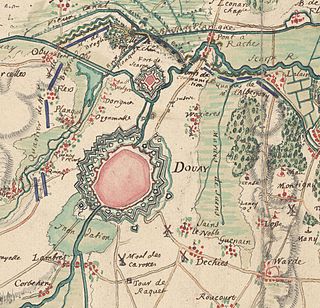
The siege of Douai, which lasted from 22 April 1710 until the capitulation of the garrison under lieutenant-general François Zénobe Philippe Albergotti on 25 June 1710 was part of the Allied Campaign of 1710 in the War of the Spanish Succession. The siege was conducted under the joint command of the Princ of Orange and Leopold I, Prince of Anhalt-Dessau and successfully concluded despite the fact that halfway through the French army under marshal Claude Louis Hector de Villars, 1st Duke of Villars made an attempt to relieve the fortress city, which led to an indecisive stand-off for four days with the Allied Army under John Churchill, 1st Duke of Marlborough and Prince Eugene of Savoy. After Douai the Allies went on to besiege Béthune.




